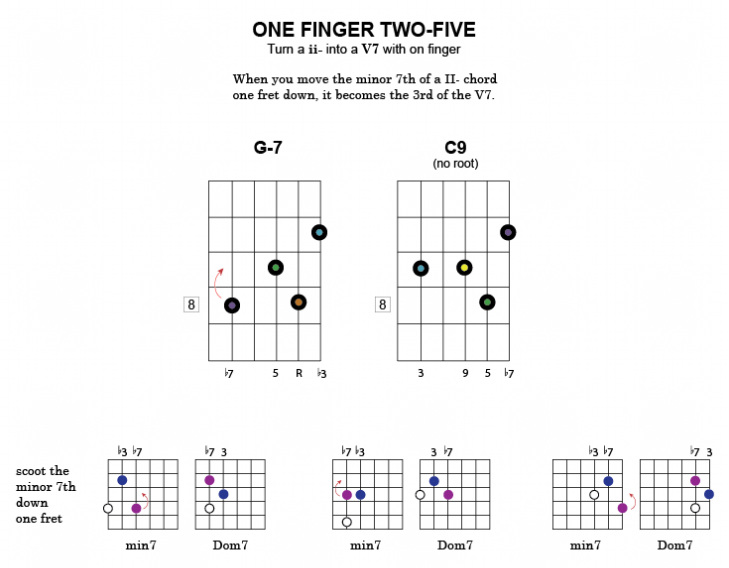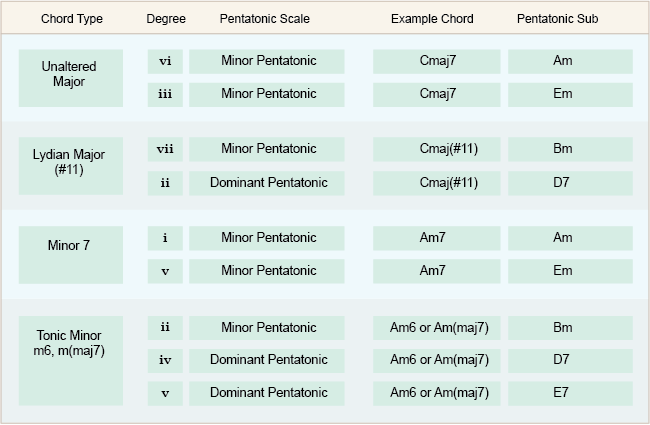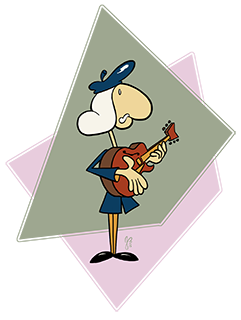| melodicminor.pdf |
|
The Melodic Minor is a minor scale with a minor third and a major seventh. It is the scale the "Major-Minor 7" chord comes from. In classical music, this scale ascends with a minor third and major seven, but descends with a flat 7 and a flat 6. The 'Jazz' minor just means the ascending version displayed below. Starting the root on the 7th of the the Melodic Minor gives you the Altered scale, or Super-Locrian. It contains the altered notes for a dominant with that root.
0 Comments
At my workshop we briefly dipped into talking about tritone substitutions and this nugget came out. On tour in South America, a pianist found a young girl who sounded remarkably like Bill Evans. He asked her what in the world she was doing to get that 'Bill Evans' sound. The girl replied she just did what her dad taught her. She just played different triads above the written chord to get flat fives, flat nines, etc. Contrasting triads will touch on different notes outside the diatonic foundation to give some moody tension. When comping, some of these triads paint in beautiful colors... others will be pretty spicy, better for stabbing and resolving more quickly. A simple example... if you have a Major C, or even a C7, on the chart, you can play the triad a full step up: D, F#, A. This gives you the b5, the 13 and the 9. If you play the 6th major triad over a root( e.g., A, C#, E over Cmaj), you get the 13th, b9 and the 3rd. If you take the tritone of C and play that triad (F#, A#, C#), you get the b5, b9, and b7. A good dominant run could involve alternating between the triads of C and F#. It sounds more complex than it really is. It's just putting a shape you already know over a chord you already know. Experiment to see which work and how. You can use it with comping or building solos. I will be experimenting with different triads over chords to see how they work together.
Here are a few altered dominant chords. These can be substituted for any functioning dominant -- any five chord going to a one chord. Altered dominants are constructed by taking a V7 chord and raising or flatting the fifth, or raising or flatting the five. You would likely use the altered scale over these chords. The altered scale is essentially the harmonic minor starting on the seventh, one semitone below its root.
When you move the minor 7th of a II- chord one fret down, it becomes the 3rd of the V7 chord in a 2-5-1 progression.
The "bebop" scale is an eight-tone scale -- eight-note scales let you play one tone for every eighth-note in a bar. You can turn any seven-note scale into a bebop scale by inserting what is known as a 'passing' tone.
These are "diagonal" scales that let you create runs while moving up the fretboard.
The Major Bebop scale has a flat-six "passing" tone between the 5th and 6th degrees. The Harmonic Minor Bebop scale is the tonic scale for a minor progression. Its passing tone connects the flat-six to the flat-seven with the Major-six. The Dorian Minor Bebop, commonly played over a ii chord in a major ii-V-I, has a Major-seven passing tone sandwiched between the flat-seven and root. The Mixolydian Bebop -- played over a V chord -- also has a passing tone connecting the flat seven to the root -- the Major-seven. The Locrian Bebop (used over the half-diminished chord in a minor 2-5-1) has a passing tone between the flat-five and the flat-six. This scale is essentially the third mode of the Mixolydian Bebop scale. When playing the scale with a beat, try starting a three-note "pickup" on the "3" of the count to give some "forward motion" to the line. This pdf shows diagonal scales which allows you to change positions and think "horizontally" along the neck.
What are the pentatonic scales and why are they useful? They are five-tone scales which remove the "trouble notes." The major pentatonic removes the notes in the 4th and 7th degree of the major scale. Those are notes which differentiate Ionian from Lydian. You don't have to worry if the Harmony calls for Lydian or not, because the 4 is eliminated from the scale entirely. The minor pentatonic removes the notes in the 2nd and 6th degree of the minor scales. Those notes differentiate the Dorian from the Aeolian from the Phrygian. Here's a PDF with the major, minor and dominant scales and their use in playing over chords.
If you start A the minor pentatonic scale with the C, then you are playing the C major pentatonic. If you play A minor pentatonic and play F# instead of G, you are playing the relative notes in the D7 Pentatonic (which of course would start on the D). The pdf shows these scales on the fingerboard. Going from the A minor Pentatonic to a D7 pentatonic, is -- you guessed it -- a 2-5 change, which would resolve to Gmaj. Here's an article on how to use pentatonics over different chords. For instance, you can play a Bm pentatonic over a Cmaj7(#11) chord. You can also play the D7 pentatonic over the same chord. Below is a chart on what dominant scales can be played over what chords. |
HI!I'm teaching myself jazz guitar... these are my notes. Archives
February 2020
Categories
All
|
||||||||||||||||||||||||||||||



 RSS Feed
RSS Feed
